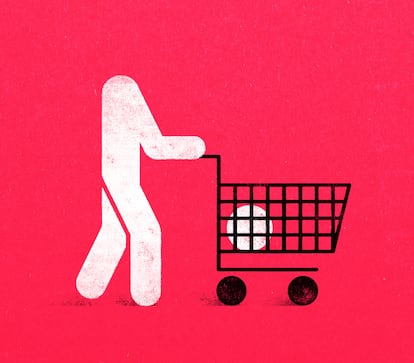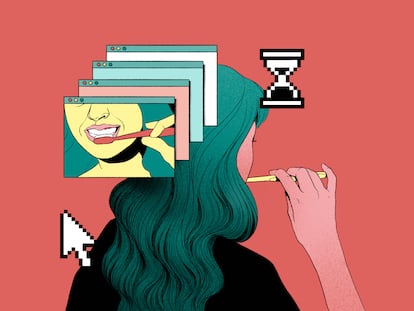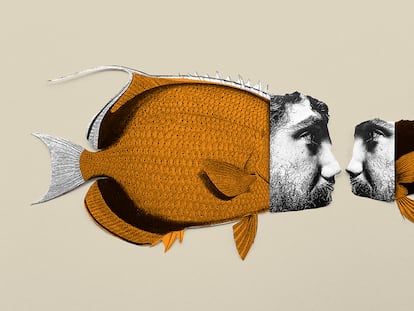Why we must break free from the powerful desire to go shopping — and how to do it
Getting out of the consumer circle comes with a great many benefits, not only in terms of our environmental impact, but also our psychological wellbeing

Shopping brings pleasure. We feel a surge of hormones when we find that irresistible bargain in the sales section or take home that garment we’ve fallen in love with. Little by little, as a result of this dynamic, we start accumulating things that don’t bring us pleasure. We are compelled by an often-silent consumerism that controls us and makes us feel good if we buy something, even if it is later abandoned in a drawer.
Evangelina Himitian and Soledad M. Vallejos, two Argentine journalists from the newspaper La Nación, decided to explore their relationship with things. They agreed not to buy anything for a year, saving for logical exceptions such as food and cleaning products. They would avoid everything else, even the hairdresser. They would not accept any material gifts and would be strict when it came to spending money on restaurants or trips. The idea was not to save money, but to break free from the cycle of consumption that ensnares us. What began as a challenge between two friends became a viral phenomenon that united hundreds of people, who also decided to say goodbye to consumerism. The journalists conquered the challenge and published a book in 2017: Deseo consumido (in English: Consumed desire). That experience transformed them and, seven years later, their lives are still changed.
We know that it’s not a good idea to go shopping if we’ve had a bad day, or to go to the supermarket when we are hungry. Emotional states condition our decisions. Levels of oxytocin — the so-called pleasure hormone — fall when something has not gone as expected. Unconsciously, we try to recover the lost oxytocin by giving ourselves something in return: a treat, a drink or a new jacket. This is how we compensate for the loss, even though it is not the most advisable thing for our wallet or for our health. Testosterone also comes into play when we go shopping. When we buy certain products, we feel more powerful and our testosterone levels rise. This process happens long before we realize it.
The mechanism is activated before we even touch what it is we want to buy: the greatest peak of pleasure in our brain does not happen when we put on the jacket for the first time. It happens much earlier: when the object appears in our mind, when we desire it, search for it or simply see it in a shop window. This mechanism is independent of gender: both men and women succumb to its charm. To make sure this doesn’t happen, we need to identify the process in ourselves and make conscious decisions. Before buying something, we should take a few seconds and ask ourselves a question: am I buying it because I really need it or because it is part of this cycle of well-being?
The goal is not to stop shopping or to embrace a minimalist lifestyle. There’s no need for that. The challenge is to change our perception of consumption. To make better use of what we already have at home. To develop exchange networks with friends and neighbors. To learn to be more creative with our belongings. And, above all, to be aware of what lies behind excessive consumption and the price we pay for it as a society. As the authors explained in our recent conversation: “A cotton t-shirt requires 300 liters of water, and there are people who do not even have that basic resource.”
When we stop succumbing to the pleasure mechanism, we are able to modify it. The path forward is easier if we have allies. We can embark on this project with someone else, sharing the challenge together and celebrating each week’s successes. Thus, little by little, we begin to enjoy simple things and intangible experiences. We are not as vulnerable to sales or promotions. Our drawers and cabinets become more spacious. And in the end, we learn to live without so many things and complications. We are freer, and we have space to enjoy what is really important, which, as we all know, can’t be bought with money.
How to get rid of what does not give us happiness
To scale back to the essential, Himitian and Vallejos propose getting rid of 10 things in the home a day. It can be something small, like an ornament that we don’t really like or that shirt that doesn’t fit very well. And so on, every day. If we live with someone, it’s a joint task: define which objects to target and the best way to decide what goes. When this becomes a habit, go through every last drawer which may be storing something that’s been forgotten.
Sign up for our weekly newsletter to get more English-language news coverage from EL PAÍS USA Edition
Tu suscripción se está usando en otro dispositivo
¿Quieres añadir otro usuario a tu suscripción?
Si continúas leyendo en este dispositivo, no se podrá leer en el otro.
FlechaTu suscripción se está usando en otro dispositivo y solo puedes acceder a EL PAÍS desde un dispositivo a la vez.
Si quieres compartir tu cuenta, cambia tu suscripción a la modalidad Premium, así podrás añadir otro usuario. Cada uno accederá con su propia cuenta de email, lo que os permitirá personalizar vuestra experiencia en EL PAÍS.
¿Tienes una suscripción de empresa? Accede aquí para contratar más cuentas.
En el caso de no saber quién está usando tu cuenta, te recomendamos cambiar tu contraseña aquí.
Si decides continuar compartiendo tu cuenta, este mensaje se mostrará en tu dispositivo y en el de la otra persona que está usando tu cuenta de forma indefinida, afectando a tu experiencia de lectura. Puedes consultar aquí los términos y condiciones de la suscripción digital.
More information
Últimas noticias
More than 40 Democratic lawmakers urge Trump in a letter to stop his ‘attempts to undermine democracy in Brazil’
The journal ‘Science’ criticizes Trump’s anti-renewable energy policy: ‘The US is failing to benefit from its own innovations’
Cubans hope for a miracle as dengue and chikungunya spread
The long shadow of the father figure in the films of Rob Reiner
Most viewed
- Christian Louboutin: ‘Young people don’t want to be like their parents. And if their parents wear sneakers, they’re going to look for something else’
- Cartels in Mexico take a leap forward with narco-drones: ‘It is criminal groups that are leading the innovation race’
- ‘El Limones’ and the growing union disguise of Mexican organized crime
- Liset Menéndez de la Prida, neuroscientist: ‘It’s not normal to constantly seek pleasure; it’s important to be bored, to be calm’
- The low-cost creative revolution: How technology is making art accessible to everyone










































